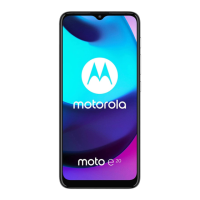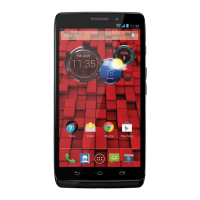
Do you have a question about the Motorola XT2155 and is the answer not in the manual?
| Category | Cell Phone |
|---|---|
| Display Size | 6.5 inches |
| Front Camera | 8 MP |
| Battery | 5000 mAh |
| Operating System | Android 11 |
| RAM | 4GB |
| Internal Storage | 64GB |
| Network | 4G LTE |
| SIM | Nano-SIM |
| Bluetooth | 5.0 |
| USB | USB Type-C |
| Sensors | Fingerprint, accelerometer, proximity |
| Display Resolution | 1600 x 720 pixels |
| Main Camera | 2MP + 2MP |
Details the phone's physical components and layout.
Instructions for inserting and removing SIM and SD cards.
Steps to transfer data from another phone to the new device.
How to configure and manage dual SIM card functionality.
Guides on setting up and managing voicemail.
Instructions for configuring email accounts on the phone.
Setting up emergency information and contacts.
Personalizing the phone with settings and customization options.
Explains the layout and elements of the phone's home screen.
Details on how to use and customize the phone's lock screen.
Guide for users new to the Android operating system.
Information on setting up and managing a Google account.
Explains the meaning of icons displayed in the status bar.
Defines common terms and features related to the phone.
Explains touch and motion-based gestures for phone interaction.
How to quickly access the camera using the power button.
Methods for switching between open applications.
Using on-screen buttons for navigation.
Accessing and customizing quick settings for frequent adjustments.
Methods to turn the screen on and off manually and automatically.
How to control different audio volumes on the phone.
Instructions for using the phone's flashlight feature.
Using voice commands with Google Assistant for phone control.
Using the phone for navigation and finding locations.
Setting up and using clock and weather widgets.
Tools for monitoring and limiting daily phone usage.
Using and customizing the virtual keyboard for text input.
Performing cut, copy, and paste operations on text.
Setting background images for the home and lock screens.
Personalizing the shortcut tray at the bottom of the home screen.
Steps to delete shortcuts and folders from the home screen.
Changing the phone's look and feel using launcher apps.
Setting up and managing screen savers.
Setting default and contact-specific ringtones.
Managing Do Not Disturb mode to silence notifications.
Selecting which interruptions are allowed when Do Not Disturb is active.
Disabling the "Hello Moto" startup sound.
Disabling sounds made when the phone is charging.
Overview of preloaded applications and how to open them.
Using Play Protect to scan for and remove malicious apps.
Using Google Assistant and the search widget to find information online.
Locating apps, settings, and phone numbers on the device.
Navigating and bookmarking websites using the Chrome app.
Downloading and updating applications from the Google Play Store.
Organizing and removing applications from the phone.
Managing app permissions for data access and features.
Core functions for handling text messages.
Composing and sending text messages.
Selecting a different app for sending messages.
Basic operations for reading, sending, and organizing emails.
Managing notification settings for incoming emails.
Creating, editing, and deleting calendar events.
Creating and managing alarms using touch or voice.
Enabling automatic time synchronization from the network.
Instructions for answering incoming voice and video calls.
Procedures for making calls using the phone app or voice commands.
Blocking specific numbers or unknown callers.
Managing call waiting to be notified of new calls.
Reviewing and removing past call records.
Dialing emergency numbers without unlocking the phone.
Adding new contacts automatically or manually.
Modifying or removing existing contact information.
Sending contact information via name cards or text attachments.
Accessing and listening to voicemail messages.
Routing calls from specific contacts directly to voicemail.
Using the camera to capture still images.
Instructions for taking self-portraits with the front camera.
Capturing wide-angle panoramic images.
Capturing images of the phone's screen.
Capturing video of the phone's screen activity.
Fine-tuning camera settings for optimal photo quality.
Removing photos and videos from the phone or Gallery.
Modifying photos and videos using editing tools.
Browsing photos and videos by source.
Methods for wirelessly sharing media files.
Backing up media files to the cloud using Google Photos.
Tuning into FM radio stations using the FM Radio app.
Playing audio files and streaming music.
Instructions for charging the phone's battery.
Optimizing settings to conserve battery power.
Identifying apps and features that consume the most battery.
Understanding and utilizing battery saving modes.
Overview of internal storage, SD card, and cloud storage.
Freeing up space on the phone's internal storage.
Moving files and apps to and from the SD card.
Choosing between portable and internal storage formats for the SD card.
Turning on Wi-Fi and connecting to available networks.
Enabling Airplane mode to disable all wireless connections.
Managing mobile data usage and settings.
Setting data usage warnings and limits to prevent overages.
Using the phone as a Wi-Fi hotspot or for USB/Bluetooth tethering.
Pairing and connecting to Bluetooth devices.
Connecting to devices directly via Wi-Fi without a router.
Mirroring phone screen or casting media to a TV.
Sharing content wirelessly with other Android devices.
Moving files between phone and computer via USB.
Printing documents, photos, and web pages wirelessly.
Modifying default apps and app behavior.
Controlling app access to phone features and data.
Customizing notification behavior for apps.
Managing which notifications appear on the lock screen.
Changing screen brightness and Adaptive Brightness settings.
Enabling dark mode for reduced eye strain and battery saving.
Selecting color profiles for screen display.
Choosing and setting up a pattern, PIN, or password.
Setting up trusted devices to keep the phone unlocked.
Setting trusted locations to keep the phone unlocked.
Setting up and using the fingerprint sensor for security.
Adding or deleting Google and other types of accounts.
Managing automatic data synchronization for Google apps.
Features to assist users with visual impairments.
Adjusting keyboard appearance, sounds, and vibration.
Managing display languages and keyboard languages.
Configuring the power button to quickly open the camera.
Selecting between gesture and 3-button navigation.
Using the fingerprint sensor to access notifications and quick settings.
Backing up phone data to a Google account.
Configuring automatic backups of phone data to Google.
Finding and recording the phone's unique IMEI number.
Diagnosing and resolving performance issues like slowness.
Troubleshooting steps for a phone that won't power on.
Steps to unfreeze or restart a non-responsive phone screen.
Troubleshooting issues related to SD card recognition and functionality.
Troubleshooting when the SIM card is not detected.
Troubleshooting dropped call issues.
Steps to resolve issues with charging the phone.
Addressing rapid battery drain issues.
Resolving issues with Bluetooth connectivity.
Resolving issues with Wi-Fi connectivity.
Troubleshooting issues with the Wi-Fi hotspot feature.
Resolving problems with USB file transfer and computer connection.
Steps to recover or reset a forgotten screen lock code.
Troubleshooting problems with account data synchronization.
General troubleshooting for app issues.
Troubleshooting issues related to the camera app.
Troubleshooting issues with sending and receiving messages.
Keeping the phone's operating system up-to-date.
Resetting network settings to resolve connectivity issues.
Erasing all data and resetting the phone to factory settings.
Resources for obtaining assistance with phone issues.











